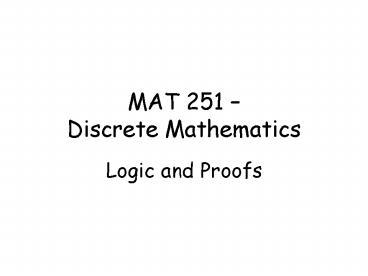MAT 251 Discrete Mathematics - PowerPoint PPT Presentation
1 / 13
Title:
MAT 251 Discrete Mathematics
Description:
are statements with two parts. ... The universal and existential quantifiers have higher precedence then the other logic operators. ... – PowerPoint PPT presentation
Number of Views:117
Avg rating:3.0/5.0
Title: MAT 251 Discrete Mathematics
1
MAT 251 Discrete Mathematics
- Logic and Proofs
2
Section 1.3 Predicates and Quantifiers
- Def Statements involving variables such as
- x y 5, y 2x 7, x gt 4
- are statements with two parts. They each have
a subject of the statement and then they have the
predicates, which refers to the property of the
subject can have.
3
Section 1.3 Predicates and Quantifiers
- These statements are not propositions until we
assign values to the subjects. We introduce the
propositional funtion notation as - let P(x) x lt 7.
- Then we can ask is P(10) true?
- Let Q(x,y) y 2x 7
- Then we can ask is P(0, 1) true?
4
Section 1.3 Predicates and Quantifiers
- Def Quanitification is another way to create
propositions from propositinal functions.
Quanitification expresses the extent to which a
predicate is true over a range of elements. - The words we use are all, some, many, none
and few. - Example Every function that is differentiable
at a is also continuous at a.
5
Section 1.3 Predicates and Quantifiers
- Def The universal quantification of P(x)
- is a statement
- P(x) is true for all values of x in the domain.
- Notation for
all/every x P(x) - An element for which P(x) is false is called a
- counterexample of
6
Section 1.3 Predicates and Quantifiers
- A Universal Quantification is true if P(x)
- is true for all x in the domain, and
- It is a false statement if P(x) is not
- always true when x is in the domain.
- Example Let P(x) be x gt 0. Determine if
- is true,
- where the domain is all real numbers.
7
Section 1.3 Predicates and Quantifiers
- Def The existential quantification of P(x) is
the proposition - There exists an element x in the domain such
that P(x). - Notation
- Domain must be clear! We read the above as there
is an x st ..., there is at least one x st , for
some x
8
Section 1.3 Predicates and Quantifiers
- An existential quantification is true if you
- can find any instances for which P(x) is
- true. It is only false when there is no
- element x in the domain for which P(x) is
- true.
- Example Let Q(x) be x2 -1. What is the truth
value of - where the domain is all real numbers?
9
Section 1.3 Predicates and Quantifiers
- There are other quantifications we can
- use. The one that is used most often is
- the Uniqueness Quantification.
- Notation
- There exists exactly one x st ,
- there is only one x st
10
Section 1.3 Predicates and Quantifiers
- Note
- We may want to restrict domains.
- We may have variables that are bound and some
that are free. - The universal and existential quantifiers have
higher precedence then the other logic operators.
11
Section 1.3 Predicates and Quantifiers
12
Section 1.3 Predicates and Quantifiers
- Example
- 1) All lions can roar.
- 2) Some chocolates are bitter.
- Express each of these statements using
- quantifiers. Then form the negation of
- the statement and then express the
- negation in simple English.
13
Section 1.3 Predicates and Quantifiers
- The notes have been created with the use
- of Discrete mathematics and Its
- Applications, Sixth Edition by K. H. Rosen

